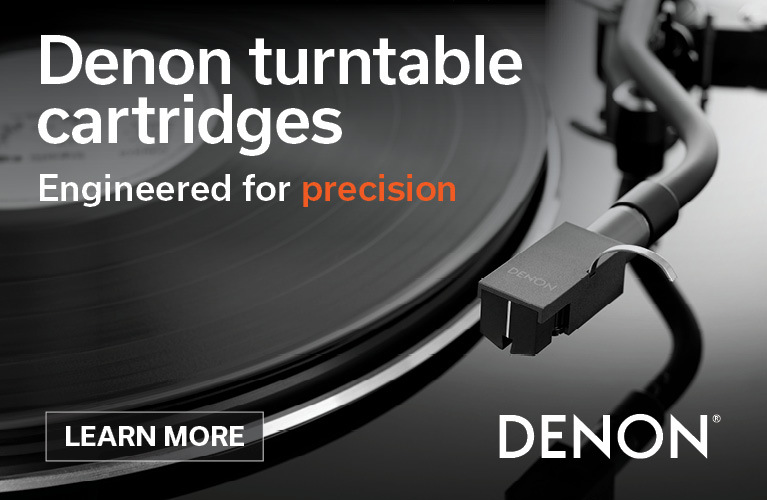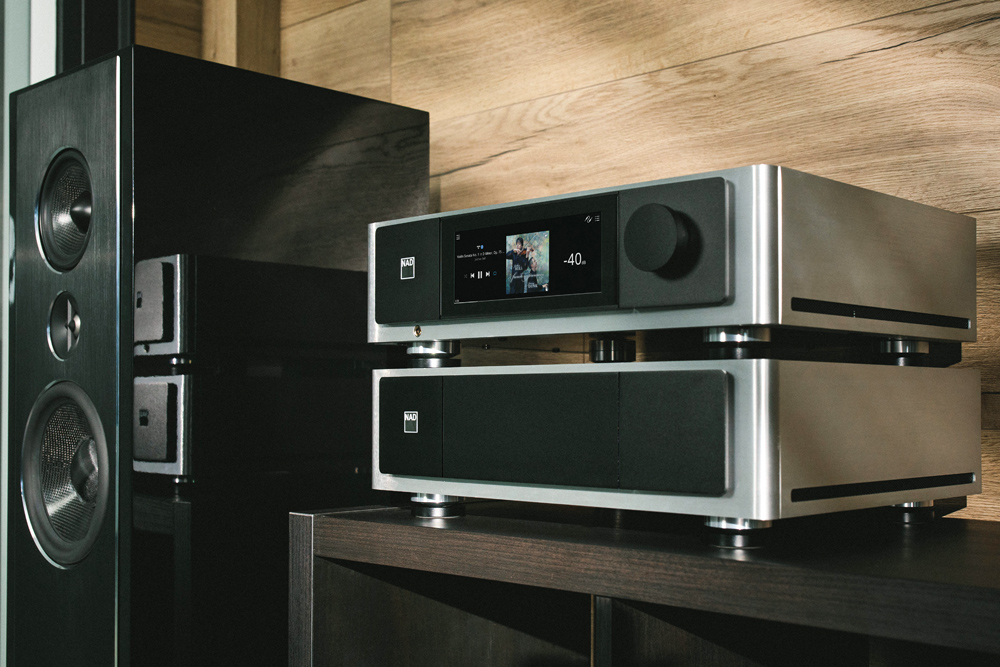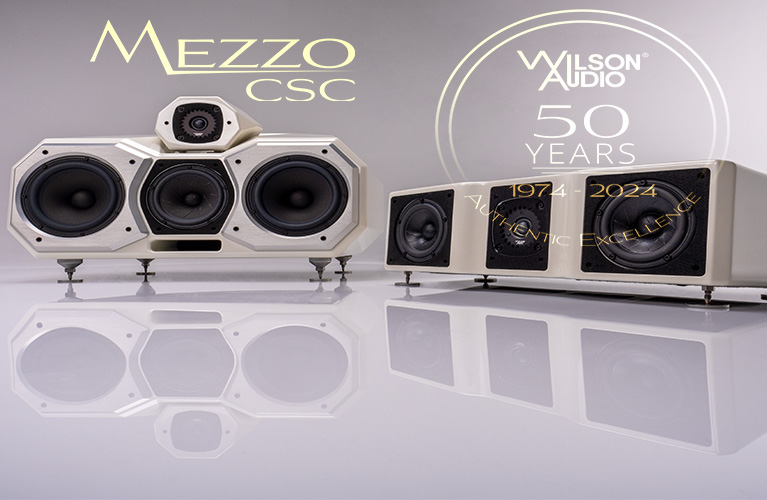NAD the venerable audiophile brand has been around a long time, its reputation built on delivering high performance audio at reasonable prices. I remember as a schoolboy hearing Pink Floyd’s Dark Side of the Moon at a Hi-Fi store played with, what seemed at the time, almost unfathomable power through a system which, I later learned, was NAD’s killer power amp of that era aptly named the ‘Powertracker’. It was many years later when I could begin treading the audiophile path, but that NAD experience was still firmly etched in my mind. The NAD Masters M66 BluOS Streaming DAC-Preamplifier arrived at my office in the morning, which seemed to make the day a little longer than usual as I was eager to get this baby home and hooked up for a listen.
Why? Because It’s Cool.
From my listening position, the M66 looks pretty slick, the display is one of the best I’ve seen. Fantastic clarity and contrast while plenty large enough to show not just the album art but the Artist, Album and Song title from a typical listening distance. There’s also an option to have the display turn into a gorgeous set of VU meters, however, on most music the pointers were close to the maximum of their range most of the time. It would be nice to have some additional upper range so that you can see the pointers bounce (but I may be nitpicking here). When adjusting the volume, the level number is displayed briefly on screen in large font and is very easily read. There’s also a status bar showing how far into the track you are. It’s very cool.
On closer inspection the M66 doesn’t quite measure up physically to the likes of the Naim Uniti Nova PE that I recently had in my possession which was more solidly built and with cleaner lines. The ventilation on top of the M66 is, in my opinion, a bit of overkill for this type of product but I understand the aesthetic matching to other Master Series products. The ventilation does however give a nice view of the high-quality internal componentry and layout, and since it was there, I felt it was perhaps a bit of a missed opportunity for providing some soft illumination from internal LEDs (as other brands do).
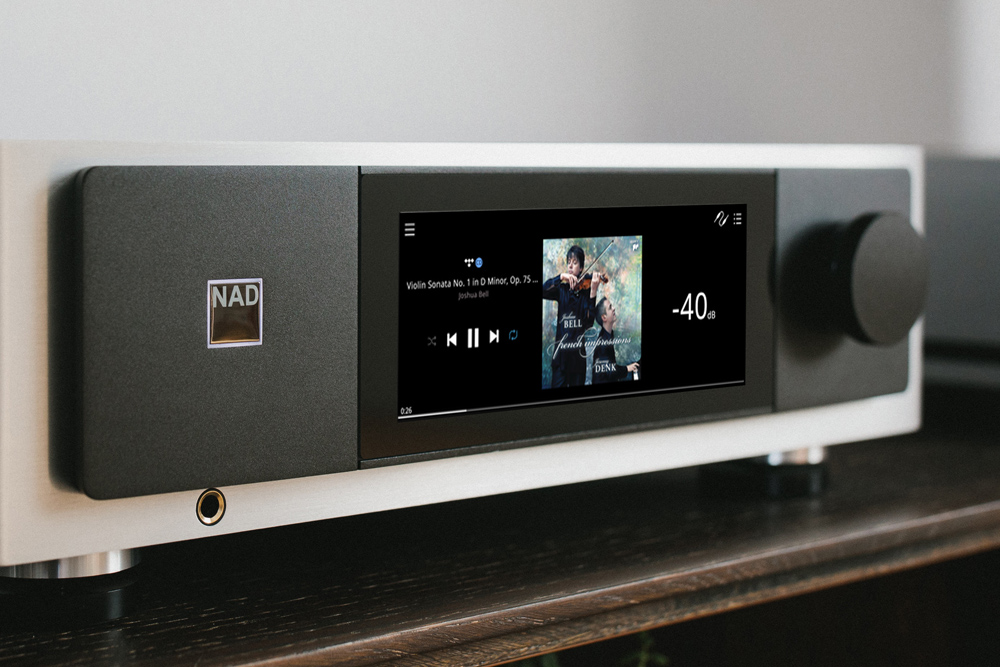
The magnetic isolation feet are an interesting design with magnetic ‘cups’ to prevent the finely tapered feet from scratching the surface that it rests on, but I found them a little fiddly to get into position. I couldn’t help feeling as though NAD’s designers have tried just a little bit too hard with the styling of the M66 instead of just letting it speak for itself. Having said that, I really do love the display. I suspect the styling will appeal to some but not to all.
Technology
The M66 is a sophisticated streaming DAC and preamplifier with analogue and phono inputs. It offers four independent subwoofer outputs, multi-room streaming, and comes with both fully licenced Dirac Live and Dirac Live Bass Control Room Correction included, making it NAD's most advanced pre-amplifier yet. The M66 features NAD’s Dynamic Digital Headroom (DDH) technology, a proprietary innovation that the company states eliminates digital inter-sample peak clipping distortion, which can occur during digital-to-analogue conversion with sudden high-frequency transients. This clever technology works to reduce the digital signal level by 3dB, rather than oversample, to allow enough headroom for the analogue filters to recreate the signal. According to NAD, inter-sample clipping distortion can often result in music that is mastered at levels which are too close to the maximum you can record on digital audio. NAD claims the benefits on these recordings are especially noticeable with percussion instruments: rim shots are said to have more impact while being less strident; cymbals are said to be more realistic and less splashy.
The M66 comes equipped with ESS Technology’s flagship ES9038 Sabre DAC. ESS Technology DACs are thought by many to be the ‘gold standard’ and are renowned for their exceptionally wide dynamic range, and ultra-low noise and distortion. Then there’s the built-in streamer, powered by the acclaimed BluOS multi-room music system which allows you to access 20+ streaming services, including lossless and high-res audio up to 24-bit/192kHz resolution and with support for MQA decoding and rendering, DSD playback and Amazon Alexa and Apple Siri voice control capabilities.
For volume adjustment, the M66 employs an ultra-precise resistor-ladder control circuit. Compared to traditional analogue circuits, the M66’s digital volume control is said to markedly reduces thermal and related distortions, maximise dynamic range, and more accurately match left and right channel output across the entire volume range. This is an important feature as the volume control in a preamp is one of the most critical components in terms of potential deleterious impact on sound quality.
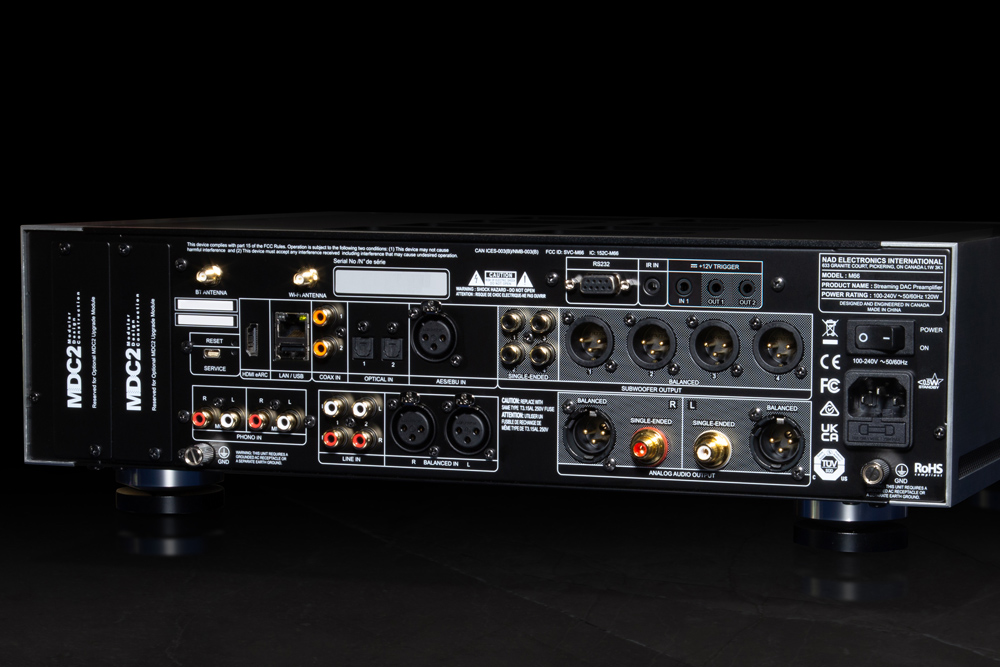
Analogue signals are, by default, converted to digital using an ESS Sabre ES9822PRO ADC (Analogue-to-Digital Converter) so that functions like Dirac Live Room Correction and Bass Control can be applied across those sources. However, the M66 also has a selectable Analogue Direct mode that bypasses all digital processing.
Internally, the analogue and digital sections are physically separated and shielded from each other with their own separate power supply sections, so that analogue signals are unaffected by digital interference when Analogue Direct mode is engaged. NAD claims this results in distinct volume attenuation, superb left and right tracking and very low noise. NAD’s designers have also provided the ability to turn off Wi-Fi and Bluetooth if they are not needed, something the engineers claim avoids unwanted high frequency pollution in the analogue signal path. The internal layout and construction, as explained by NAD’s Cas Oostvogel separates and shields the analogue sections from the digital sections to minimise unwanted noise and interference while internal componentry such as op-amps and resistors are said to be of the highest standard.
The BluOS interface is very intuitive. I was able to point it to my music library on my ageing WD MyBookLiveDuo NAS and after an hour or so of indexing it had full access to my music. The BluOS app provides access to the settings and configuration of the M66 (replay gain, balance, tone controls etc.) and it allows you to select inputs, select music services, control the volume, and engage Dirac Live filters. BluOS also provides access to artist and song information courtesy of LastFM. It’s almost like having a free version of Roon at your fingertips. The M66 is also supplied with an old school remote control which is a hefty aluminium wand sort of thing, but I never really used it, preferring to use my smartphone loaded with BluOS and Roon.
Also on-board is a HDMI eARC port with CEC (Consumer Electronics Control) which when connected to CEC-capable smart TVs will allow the TV remote to control the system volume. Nice! The M66 provides both unbalanced RCA and balanced XLR options for connecting to your power amplifier(s) and on the input side there are two optical and two coaxial S/PDIF inputs, one AES/EBU balanced digital input, two pairs of RCA line-level analogue inputs, and one pair of XLR balanced inputs. Safe to say in terms of connectivity, the M66 has you covered.
But wait, there’s more… the M66 also includes a dedicated high quality headphone amplifier, and one which has low output impedance and high maximum output voltage, which NAD says enables it to drive demanding high-impedance studio monitor headphones. The M66 also has Bluetooth connectivity, with support for the AAC, LDAC, and aptX HD codecs.
The M66 incorporates sophisticated room correction technology from Dirac, a business which was founded by a group of PhD students from Uppsala University in Sweden in the early 2000s, and which was initially focused on improving sound quality in studio environments. The founders of Dirac realised that great loudspeakers don’t always guarantee an exceptional audio experience because room acoustics are often the weakest link in most hi-fi systems. While acoustic room treatment can certainly help, Dirac’s digital room correction they say helps your loudspeakers reach their full potential in any listening room. With Dirac Live, and the supplied microphone, you can easily measure the acoustic characteristics of your loudspeakers and room.
The measurements consider the size, distance and reflections from walls, ceilings and other objects in the room which can create standing waves and other distortions. It then generates correction filters that compensate for these acoustic problems and calibrates the system to reproduce sound as it was originally intended. This often translates to more textured bass, improved tonal accuracy, improved clarity, and more focused imaging.
The M66 also features Dirac Live Bass Control, which enables the M66 independent calibration of up to four subwoofers which are optimised in both the frequency and time domains. This allows a more natural blend between the subwoofer(s) and the main speakers. Having four subwoofer outputs on a stereo component may sound counter-intuitive, at first. Yet, bass issues are by far the most difficult problem to fix in any listening room (almost impossible with only acoustic treatment) and the most effective way to fix this is, in fact, to have multiple subwoofers working collaboratively. It's a balance of using frequency and phase correction to reproduce what for one subwoofer may be a null room mode, created by unwanted wave cancellation at a specific frequency, and to reduce what for another subwoofer is frequency overload created by wave summation. These nulls and overload are determined by the room dimensions.
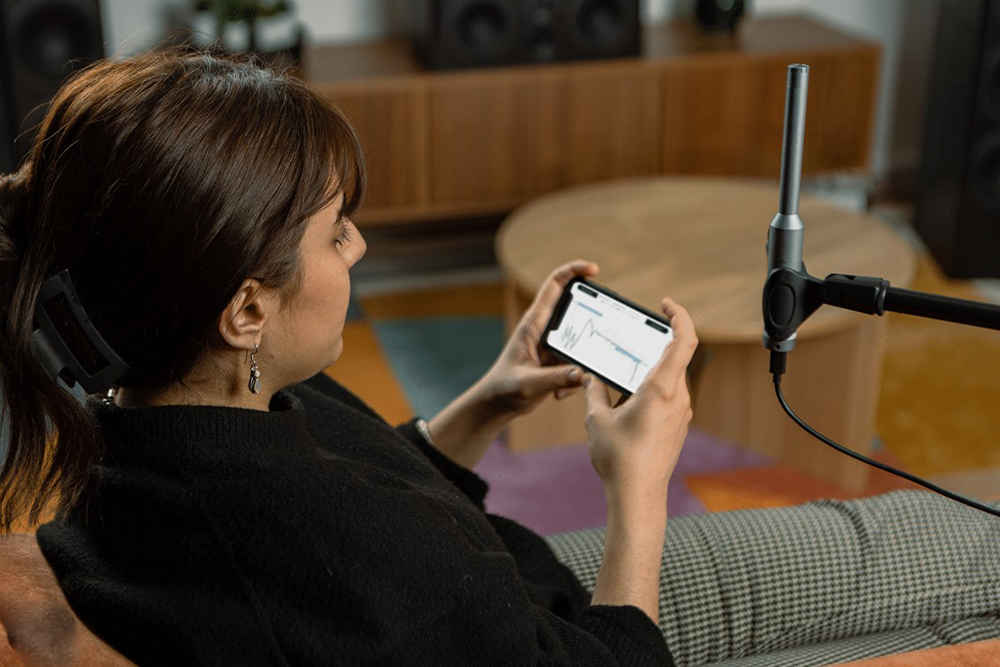
This type of correction takes a lot of processing power but, if done correctly, it can greatly improve the quality of bass throughout the listening area. This is an incredibly powerful feature enormously increasing the value proposition of the M66. As Cas Oostvogel explains, to do this with Dirac outside of the M66 will take additional hardware on top of software licensing costs which alone are in the order of around US$800!
As if that wasn’t enough, NAD has built in a high-quality ultra-quiet MM/MC (Moving Magnet/Moving Coil) phono stage with precise RIAA equalisation and high overload margins. The built-in infrasonic filter will remove signal artifacts below 15Hz which can add nothing to the musical content while robbing the system of power and cause excessive cone movement and distortion.
Set Up and Fine Tuning
Despite numerous attempts I could not get the Dirac iPhone app to recognise the microphone on the M66 however it was quite straightforward after connecting the microphone to notebook PC. Considering it’s a onetime operation, and the detailed information provided in the setup screens, I’m sure it would be easier to see on the larger screen of a notebook PC anyway. I commenced by downloading and installing the NAD microphone calibration file which ensures a flat response necessary for an accurate room measurement. Dirac recommends several room measurements within the listening position for best results which provides for some variation in your exact seating position. The measurement process is easy with minimal user effort other than setting the correct volume level.
As far as my measurements pattern, I performed a five-point calibration using a microphone stand and a measuring tape to position the microphone at head height. This was done across five points on and around my couch.
Dirac automatically calculates the appropriate compensation filters based on a combination of your speakers’ response and the room interactions. You can fine tune the calculated compensation filter if desired using the control points which act like a parametric equaliser (although it was limited to adjusting the amplitude rather than the bandwidth or ‘Q’) to suit your personal preferences. In my experience fine tuning can be a treacherous path, making some music sound better and other music sound worse. I decided to stick with the auto-generated compensation filter.
I tested the Dirac functionality in two scenarios, the first with my SVS SB3000 subwoofer supporting the Sonus faber Amati Homage speakers, and the second running just the Amati (my usual setup). In both scenarios, with the Dirac filter on, the system had more clarity and cohesiveness in the bass than what I was able to achieve without Dirac, however I preferred my Amati Homage without the subwoofer. I would have loved to have another couple of SB3000s on hand to fully explore the capability of Dirac Live Bass Control.
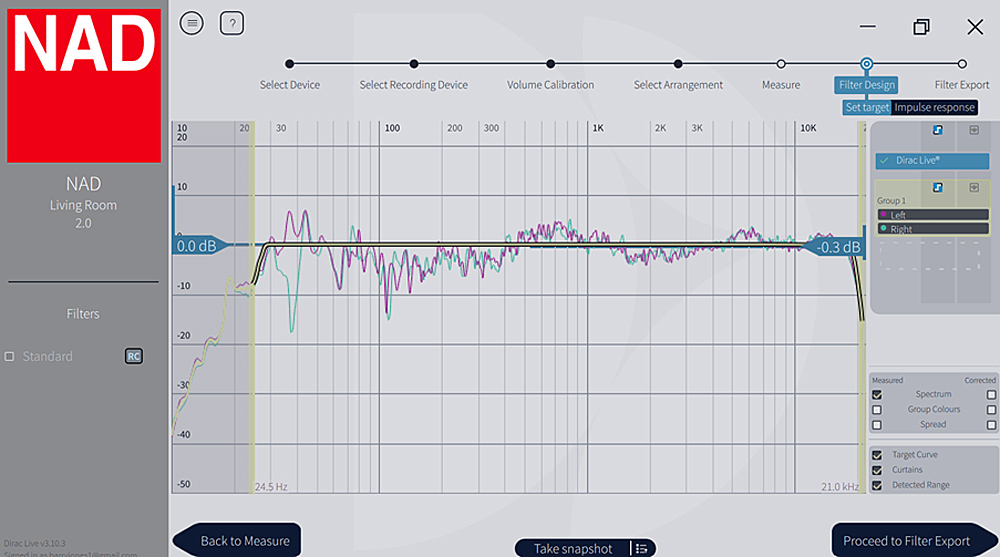
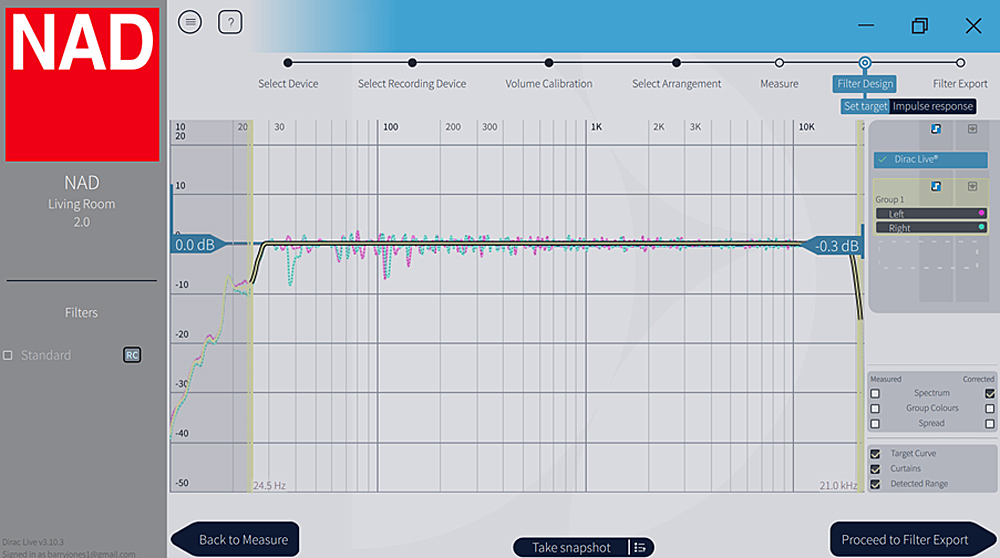
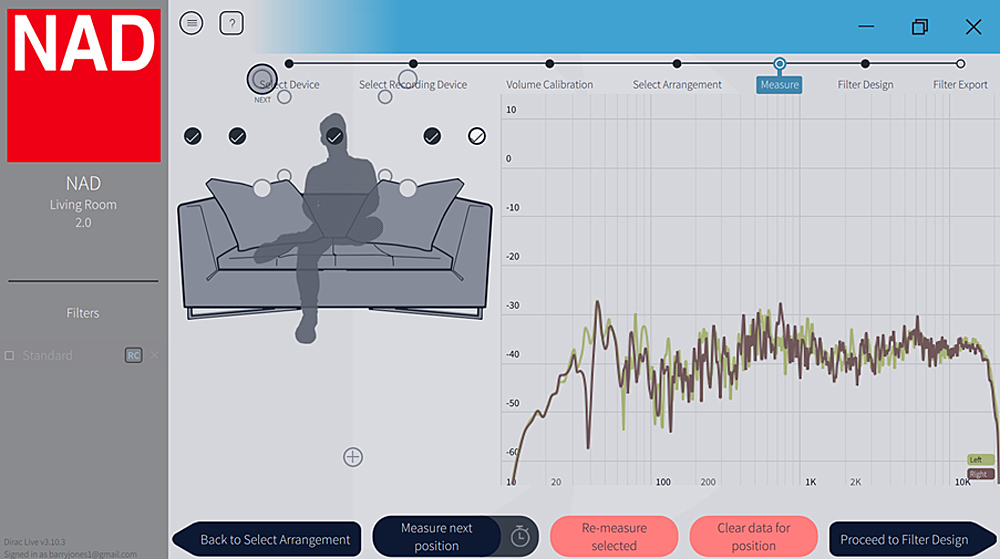
With Dirac not only is the bass more clearly defined as room effects are countered, but the effect extends into the vocals and instruments, such as the piano, which acquire a greater sense of depth allowing them to stand out more clearly in the soundstage. It’s interesting because I already had what I would describe as a realistic and detailed soundstage with good width and front-to-back depth, but with Dirac filters engaged, the effect is magnified, and it becomes even more natural sounding.
I’ve tried a number of room correction systems over the years including DSPeaker, DEQX and Linn and can confidently say Dirac is up there with the best of them. Unlike some room corrections which result in a very ‘flat’ or ‘dry’ sound, and often is lacking in bass, the Dirac correction has no such issue. Plus, it’s so simple to implement.
Which is not to say that digital room correction is the be all and end all – I would always recommend first treating the room passively as much as you can with a combination of bass traps, absorption and diffraction to minimise the amount of correction necessary in the digital domain, but when it comes to applying the finishing touches it’s good to know that with Dirac you’re in good hands.
Listening
I played Chris Jones’ “Would Not Have It Any Other Way” from his Moonstruck album at low volume, careful not to wake my 11-year-old daughter sleeping upstairs. Even at a relatively low level, all the detail was there. Jones’ vocals and the guitar were clear and powerful. Very natural sounding.
Ben Sidran’s “Who Are You” from the album Picture Him Happy is another piece that can show off the naturally smooth, detailed character of the M66. Ben’s voice is solid and focused. On “Dying Anyway” from Don’t Cry for No Hipster, the cymbals are pristine – there’s absolutely no splashiness and the piano has the lovely rich resonance that you would expect – no exaggerated bloom and no trace of hardness.
Laura Marling’s “Ghosts” from her album Alas I Cannot Swim was the stand-out compared to my recollection of recent auditions. The percussion seemed more precisely placed in the soundstage. Not just the placement but it had more apparent physical presence and the subtlety of how hard and how precisely it was struck. Bass had more clarity and vocals had more in-room presence, with the backing vocals more clearly separated.
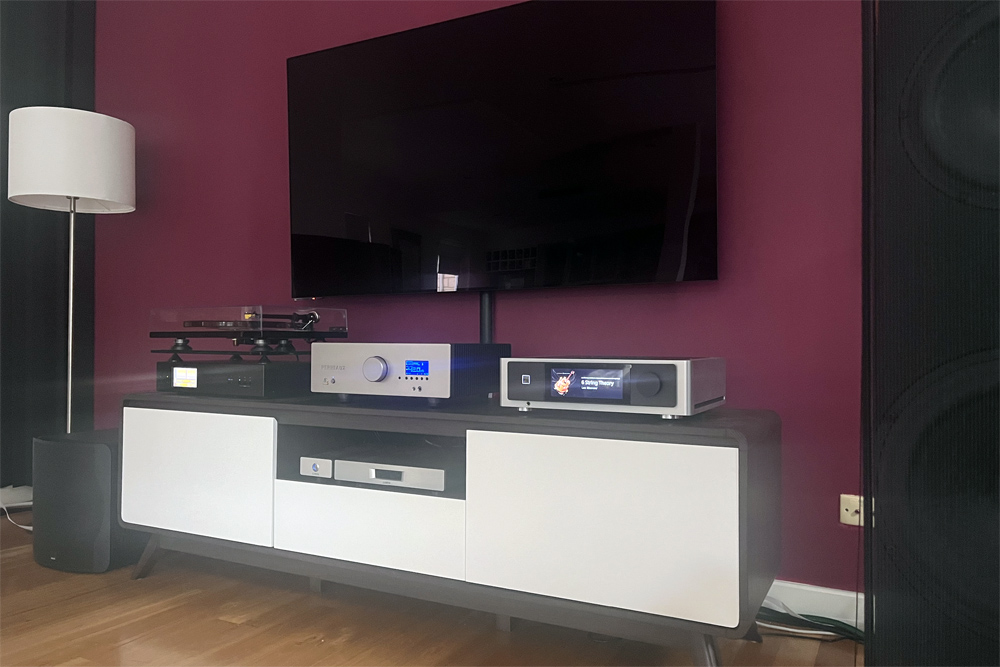
Kyrie Kristmanson and Quator Voce’s “Allenor” from the album Modern Ruin provided a spacious arrangement. Vocals and cello were excellent, and the bass was powerful but free from bloom thanks to Dirac. The percussion had the requisite attack when the bow was slapped against the strings. There was great transient response, yet in the gaps of silence there is… silence. The M66 introduces no perceivable noise.
The vocals on “Hard to Thrill” by J.J. Cale and Eric Clapton from their The Road to Escondido album were almost startling. Again, the cymbals were excellent, and the piano was very natural sounding, while the blues guitars were right there in my room. Sublime...
Having been to hear Asher Fisch and the Western Australia Symphony Orchestra (WASO) perform Wagner’s Ring Cycle a few weeks ago at the Perth Concert Hall, I was keen to hear what the M66 would make of it. For me, with classical music, especially that which I have heard live, I find that unless the combination of recording and playback is able to achieve a certain level of realism, I’m not able to properly enjoy it. I searched the Qobuz catalogue, interested in a version which was somewhat like the one I heard live, which was without a choir. Eventually I settled on the Telarc version conducted by Lorin Maazel and the Berlin Philharmonic Orchestra. What I heard through my system with the M66 was breathtaking. Up there with my DEQX HDP5/Lumin. I was hard pressed to pick which I preferred. On some music it was the M66 and on other music the DEQX/T1 which is a far more expensive combination.
To test out the phono stage, I chose a few tracks from Steely Dan’s Aja album [Cisco CLP-1006] and compared my Rega Aria phono preamp fed by the Rega RP6 with Exact-2 cartridge to the MM phono stage of the M66. Not surprisingly, the all Rega front end was the winner (perhaps benefiting from system synergy) however I wasn’t expecting the M66 to get as close as it did. The sound was fast, powerful and detailed. The M66 was incredibly quiet and free of noise, a testimony to the thoughtful signal handling inherent in the design of the M66. For vinyl aficionados wanting to avoid the expense and clutter of additional analogue boxes, the M66 is a no-brainer.
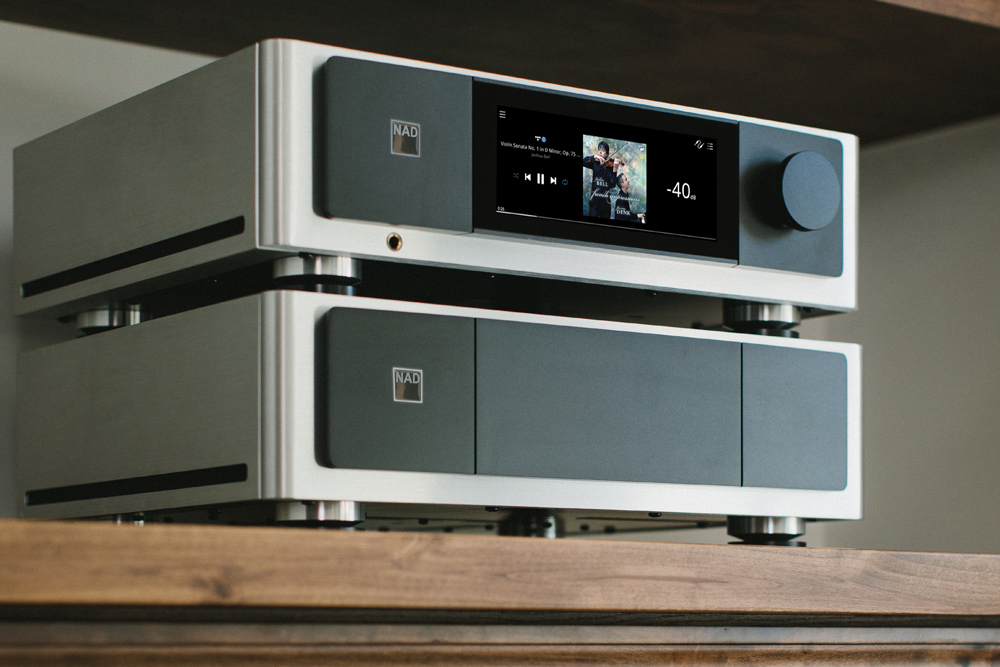
If there were any sonic criticisms of the M66, they would seem very nitpicky considering the outstanding performance and its price. But anyway, here goes. Compared to some other top end components I happened to have on hand, the M66 seemed to lack just a little precision in the height dimension mostly on vocals, but this was only noticeable on some tracks. Also, frequency extremes – again only evident on some music – sometimes could seem a little rolled off. However, I hasten to add, my existing setup also seemed that way in similar comparisons, so, it’s not unique to the M66 but perhaps more a testament to what much more expensive top-end components can provide.
That said, in no way did this stop me from enjoying many hours of listening to music on the M66, both with old favourites and when discovering new tunes. The fact is that in our pursuit of playback perfection, there’s always going to be something better out there. If not now, then around the next corner, for sure. But that doesn’t need to stop you experiencing the thrill of hearing music in your home that sounds as good as it does when you’re out (in many cases I think it can sound even better).
Conclusion
Everything I played on the M66 sounded great. It is often said that sometimes the highest quality components won’t make bad recordings sound better. I have also found that sometimes what you think is a bad recording actually isn’t as bad as what you thought it was. As a streaming DAC the M66 is pretty darn good, but when you add the Dirac room correction it’s elevated to a whole new level.
The M66 is an exceptional component providing an incredibly powerful set of features at a very affordable price. When partnered with the right amplifier (perhaps an M23 from the NAD Masters range) you’d have to spend a lot more to put together a system that could come close to the level of performance possible here.
True to its objectives, NAD has provided a truly killer piece of gear at an affordable price.
… Barry Jones
www.soundstageaustralia.com
Associated Equipment:
- Speakers — Sonus faber Amati Homage
- Amplifier — Perreaux e250i 40th Anniversary Edition integrated amplifier with Eloquence DAC
- Sources — Digital: Lumin T1, Oppo BDP-105D Analogue: Rega RP6 turntable, Rega Exact-2 cartridge, Rega Aria phono stage & Rega Couple interconnects
- Processor — DEQX HDP-5
- DAC/Headphone Amplifier — Chord Mojo DAC
- Headphones — AudioQuest Nighthawk
- Cables — Nordost White Lightning, Kimber Cable Timbre balanced and Van den Hul D-300III unbalanced interconnects, Atlas Compass Digital Coaxial Audio Cable, QED Performance Graphite USB
- Miscellaneous — Isotek Sirius Power Conditioner, 8 x Auralex SA8600 bass traps in front wall corners, 12 x Sound Acoustics MP700-40 ceiling acoustic panels
NAD Masters M66 BluOS Streaming DAC-Preamplifier
Price: AU$9299
Australian Warranty: Five Years
Australian Retailer Finder/Listing Link
Australian Distributor: Amber Technology
+61 (0) 2 9998 7600
www.ambertech.com.au
NAD Electronics
Lenbrook Group
633 Granite Court
Pickering, Ontario
Canada L1W 3K1
+1 905 831 6555
www.nadelectronics.com

